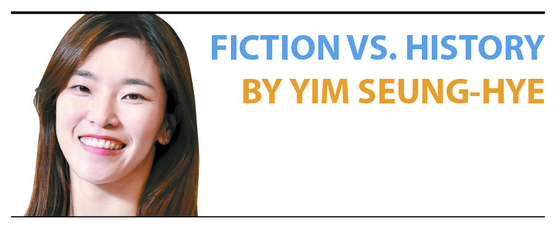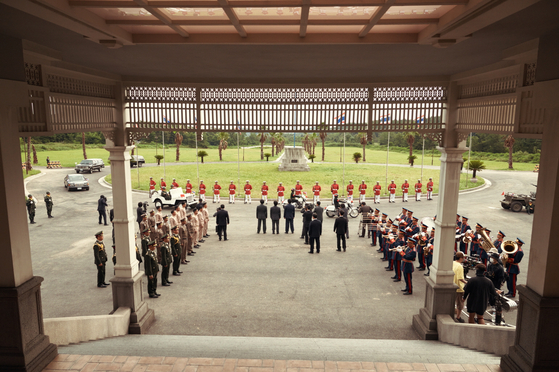[FICTION VS. HISTORY] Lee Jung-jae’s 'Hunt' enhances Korea's history with elements of fiction
In film and television, historical dramas have never gone out of style. Fans of period dramas, both in Korea and abroad, like to be transported to a different time and learn about the stories that swept up — or were put in motion by — our ancestors. Some watch to see how the present compares with the past. Others watch to see progress. Foreign Korea-philes can get a crash course in Korean history while watching historical films. But all historical dramas create characters, add romantic plots and conflate or invent events to make sure viewers don’t lose interest. With Fiction vs. History, the Korea JoongAng Daily attempts to distinguish fact from fiction in popular period dramas and films for clarification and to dispel misunderstandings.![Actors Lee Jung-jae, left, and Jung Woo-sung feature in Lee's directorial debut film "Hunt." Lee is the chief of the foreign intelligence unit and Jung the domestic cheif at the Agency for National Security Planning (NSP), which was formerly called the Korea Central Intelligence Agency. [MEGABOX PLUS M]](https://koreajoongangdaily.joins.com/data/photo/2022/11/06/ea411016-9b16-4846-9f53-42d1848b4cb9.jpg)
Actors Lee Jung-jae, left, and Jung Woo-sung feature in Lee's directorial debut film "Hunt." Lee is the chief of the foreign intelligence unit and Jung the domestic cheif at the Agency for National Security Planning (NSP), which was formerly called the Korea Central Intelligence Agency. [MEGABOX PLUS M]
Convoluted espionage thriller “Hunt” is “Squid Game” star Lee Jung-jae’s directorial debut. The film offers a glimpse of what Korea was like in the early 1980s when the country was under yet another repressive regime with former army general Chun Doo-hwan taking control through a coup in 1979 in the aftermath of the assassination of president Park Chung Hee, another military dictator who had been ruling since 1962.
The plot revolves around two top agents working for the Korea Central Intelligence Agency (KCIA), whose name changed to the Agency for National Security Planning (NSP) after Chun took office. The pair try to figure out who the North Korean mole is.

Korean viewers, including younger ones, are well aware of some of the historical events that took place during this dark period of Korean history like the 1980 pro-democracy uprising in Gwangju, during which hundreds, if not thousands of Korean university students were killed while demonstrating against Chun's regime. But including so many events may leave some foreign viewers scratching their heads at the end of the film, wondering what’s real and what’s fiction.
![Students protest in Gwangju, South Jeolla for democracy on May 18, 1980. The protest lasted until May 27 and martial law took the lives of thousands of young Koreans' lives. [JOONGANG PHOTO]](https://koreajoongangdaily.joins.com/data/photo/2022/11/06/44362df8-ff5e-49a2-82eb-84716e69cb33.jpg)
Students protest in Gwangju, South Jeolla for democracy on May 18, 1980. The protest lasted until May 27 and martial law took the lives of thousands of young Koreans' lives. [JOONGANG PHOTO]
The director himself said at various screenings, most recently in London at the “London East Asia Film Festival” on Oct. 19, that “Hunt” is “50 percent fantasy and 50 percent reality.”
“Hunt” premiered in the United Kingdom and was released on streaming services on Nov. 4. It will hit theaters in the United States in December.
![Jang in an investigation room to find out who the North Korean spy known as Dong-lim is. [MEGABOX PLUS M]](https://koreajoongangdaily.joins.com/data/photo/2022/11/06/d08b747b-a0e6-4471-9682-e4844f59dcff.jpg)
Jang in an investigation room to find out who the North Korean spy known as Dong-lim is. [MEGABOX PLUS M]
The film starts off with a scene showing Korean-Americans protesting against then-President Chun as he visits the United States for a summit in 1983. Both chiefs of the domestic and foreign intelligence units of the NSP are present at the scene to protect the president, and together with the CIA, stop a terror attack against Chun. The chief of the domestic unit is played by Lee’s long-time best friend actor Jung Woo-sung. His counterpart, the chief of the foreign unit is played by Lee himself. They work under the same office but are portrayed somewhat like competitors, trying to figure out who the North Korean spy is, both having suspicions about each other. Jung's character, named Jung-do, was also once an interrogator of Lee's character Pyung-ho, and tortured him before the regime change as it was Lee’s character's boss who assassinated the president in the middle of a dinner party.
It’s a known fact that President Park was assassinated during a dinner hosted by Kim Jae-gyu, who was then the director of the KCIA on the evening of Oct. 26, 1979. This may cause some to think that the main characters are based on real people, but they are in fact, fictional. There were numerous attempts to kill former president Chun by North Korea, but never in the United States and Chun’s first visit to the U.S. was in 1985.
![A photograph of South Korean government officials just before the bombing at the Martyrs’ Mausoleum in Yangon in Myanmar on Oct. 9, 1983. The bombing was planned by North Koreans to assassinate former South Korean president Chun Doo-hwan. [YONHAP]](https://koreajoongangdaily.joins.com/data/photo/2022/11/06/bfba4849-c719-4501-bd7f-d3bb42ed78a5.jpg)
A photograph of South Korean government officials just before the bombing at the Martyrs’ Mausoleum in Yangon in Myanmar on Oct. 9, 1983. The bombing was planned by North Koreans to assassinate former South Korean president Chun Doo-hwan. [YONHAP]
![The scene of Martyrs’ Mausoleum in Yangon in Myanmar, four days after the terror attack on Oct. 13, 1983. [YONHAP]](https://koreajoongangdaily.joins.com/data/photo/2022/11/06/4c6753ee-2687-4cbe-aa2e-3198174ec3c7.jpg)
The scene of Martyrs’ Mausoleum in Yangon in Myanmar, four days after the terror attack on Oct. 13, 1983. [YONHAP]
The major terror attack against Chun by North Korea was in Myanmar in 1983, which resulted in the Burmese government cutting diplomatic relations with Pyongyang. It was on Oct. 9, 1983. North Korea bombed the Martyrs’ Mausoleum in Yangon in an attempt to assassinate Chun, who was planning to visit to attend a ceremony to commemorate Burmese nationalist hero Gen. Aung San (1915-1947). News reports back then reported that North Korean terrorists had set off a bomb a bit too early after hearing a band playing the South Korean national anthem, misinterpreting it as a signal that the president has arrived. The band was just rehearsing and the president was running late, stuck in traffic. Though the attack missed the president, it killed 17 South Koreans — including the deputy prime minister and foreign minister — and four Burmese nationals.

![The scenes in the film depicting the terror attac in Myanmar. In the film, the location is changed to Bangkok, Thailand. [MEGABOX PLUS M]](https://koreajoongangdaily.joins.com/data/photo/2022/11/06/d6532cfc-40e4-48d4-83e0-775035696c09.jpg)
The scenes in the film depicting the terror attac in Myanmar. In the film, the location is changed to Bangkok, Thailand. [MEGABOX PLUS M]
The event also appears toward the end of the film and is covered in quite some depth. But in the film, the location is not Myanmar, but Bangkok, Thailand. It looks like Lee took a motif from many of the photographs that survived from the real event as the scenes will remind many Korean viewers of the incident. By this point, viewers realize that it’s both North Koreans and South Koreans that want to assassinate Chun, which is also fiction. But, now, it is the North Korean spy (the mole) who tries to stop the terrorists from carrying out the bombing, while the South Korean agent in the NSP wants it to go ahead.
![Korean government welcomes North Korean defector Lee Ung-pyong. Lee crossed the border in his MiG-19 fighter jet lands on Feb. 25, 1993. [JOONGANG PHOTO]](https://koreajoongangdaily.joins.com/data/photo/2022/11/06/62ee9a00-02d2-4685-9641-0df5e6fbbb12.jpg)
Korean government welcomes North Korean defector Lee Ung-pyong. Lee crossed the border in his MiG-19 fighter jet lands on Feb. 25, 1993. [JOONGANG PHOTO]
The film also features veteran actor Hwang Jung-min. He plays a North Korean pilot who flies across the heavily patrolled demilitarized zone in his MiG-19. He signals for surrender, lands his jet on a South Korean air base, and is investigated by the two chiefs of the NSP. He suddenly asks the agents to cook him a South Korean-style ramyeon and takes a bite and tells them this is why he decided to defect to South Korea. He says he was walking along the beach in Wonsan, which is located in Gangwon Province, near the border, and picked up a scrapped packaging of a South Korean ramyeon that had drifted to the beach. He said he was astonished by what it said at the back of the packaging: Products that have been damaged in the course of sales or distribution will be exchanged at a nearby distributing store or at the headquarters. He tells the agents that he decided to come to the South because it seemed like a land that has freedom, a land that can exchange a packet of ramyeon for its people.
![The MiG-19 supersonic fighter jet that Lee flew to Korea in. [JOONGANG PHOTO]](https://koreajoongangdaily.joins.com/data/photo/2022/11/06/296884ea-340e-4a34-8b3a-22425ea900e1.jpg)
The MiG-19 supersonic fighter jet that Lee flew to Korea in. [JOONGANG PHOTO]
Due to the comical elements of this scene, viewers might assume that Lee deliberately added this fictional event. But in fact, for some Koreans, that day would still be vivid in their minds. It was Feb. 25, 1983. Air-raid sirens were sounded, warning the citizens of Seoul of a possible emergency situation. They immediately stopped their cars, went indoors and tuned into radios and television news to find out what was going on. The government soon announced that a 28-year-old North Korean air force captain was attempting to defect to the South. The scene is entirely based on history, except for the part where he orders ramyeon inside the interrogation room. The atmosphere inside the room would’ve been a lot more serious than depicted in the film. The pilot received 1.56 billion won ($1.1 million) from the South Korean government for bringing the MiG-19 with him, a huge sum considering the fact that the packet of ramyeon he saw was 100 won at that time.
There are several other historical events that the film touches on. Jung-do brings up a scandal in the film during dinner at his house with Pyung-ho. He tells his colleague that he can’t believe the news of how one of their former co-workers could engage in fraud that amounts to about 640 billion won. He says it’s hard to believe as one needs about 30 million won to own an apartment in Gangnam. This is also a historical fact — referring to probably the biggest underground loan scam in Korea’s history.
![The infamous Chang Young-ja gets arrested on May 4, 1982. Her husband Lee Cheol-hee also got arrested on the same day. The couple engaged in a multimillion-dollar loan scam. [JOONGANG PHOTO]](https://koreajoongangdaily.joins.com/data/photo/2022/11/06/451798dd-0d48-480e-abca-81669580ddf2.jpg)
The infamous Chang Young-ja gets arrested on May 4, 1982. Her husband Lee Cheol-hee also got arrested on the same day. The couple engaged in a multimillion-dollar loan scam. [JOONGANG PHOTO]
The case happened in 1982 when Chun was still president. A woman named Chang Young-ja became known as the “curb money queen” in Korea. Her husband Lee Cheol-hee, a former KCIA official, used his network and influence to help his wife’s business as one of the country’s leading lenders in the non-bank lending market. The two ultimately engaged in this multimillion-dollar loan scam, which resulted in Korea’s two leading firms to go into bankruptcy. The couple was arrested on May 4, 1982 on suspicion of smuggling $400,000 out of the country into the U.S. and later was also charged with fraud for lying about their political connections.
BY YIM SEUNG-HYE [yim.seunghye@joongang.co.kr]










with the Korea JoongAng Daily
To write comments, please log in to one of the accounts.
Standards Board Policy (0/250자)